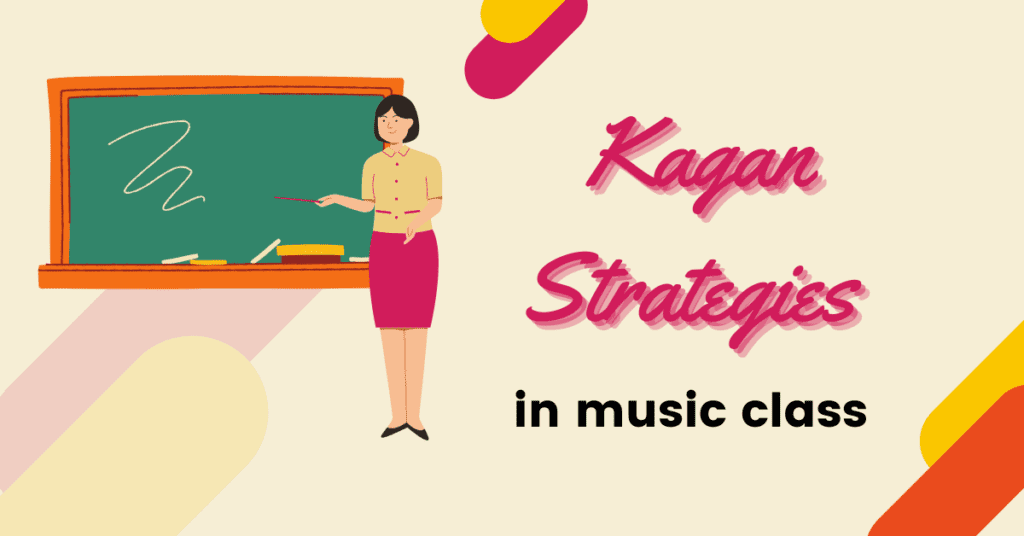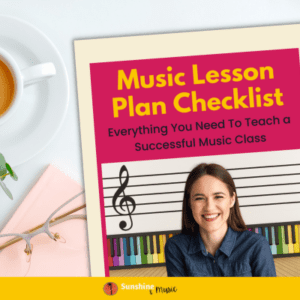Hey there music teachers! Any of you out there ever heard of Kagan strategies and wondered how they would work in music class? I heard several classroom teachers mention them before, but didn’t really know what it was. I gathered that it was a cool set of strategies you could use in your classroom to help students learn better. So, when I heard that I could take a free 2-day training through FDLRS (a resource available to Florida-based teachers), I decided to sign up. And wow! There are some really awesome things that I took away from it that I want to share with you today.
Why Should I Care About Kagan?
Good question! There are so many fads out there, who has time to look into every little set of tricks? I agree, but this one you should check out. It is one of those tried and true – like reading Wong’s “First Day of School” – it’s a classic for a reason. Here’s what makes Kagan special.
- uses the stuff you use all the time like think, pair, share or talk to your partner, but turn them up a notch by adding structure, so that every kid participates.
- addresses the needs of kids to socialize and be part of a community, and builds that in to the learning strategies.
- helps solve that problem of kids that won’t work together.
How It Works
There are lots of different strategies, and I’m not going to get into all of them here, but lets take the example of Think, Pair, Share. Normally, you would have kids think about the topic, then talk with a partner, then share with the class. But here is the problem we get: students might turn to a friend and leave another person without anyone to talk to. Or, they might not talk at all.
So, we pop in some Kagan strategies to add a little structure and here’s what we get. Students have an assigned partner and an assigned letter – A or B. I would tell person A they have 30 sec (or whatever amount of time you decide), to answer the question. Then person B gets 30 secs as well to answer. A good example of a question to use with a time limit such as this is “Name everything you remember about music class last year” or “Tell your partner your favorite composer and why.” Something that will allow them to fill the time (aka not a one word answer). Now, every student has a job and specific person that they answer to (who generally monitors that they are answering the question), and they have a specific time that they talk.
Another way you could do it is a question like “Name as many percussion instruments as you can think of”. Students take turns saying names of instruments until time runs out. So now, instead of controlling by TIME (30 sec/person) you are controlling by TURNS (A-B-A-B) etc.
How Do You Organize This In Music Class?
Kagan gets really detailed when talking about grouping. You can really go full throttle and group by abilities (go take a Kagan class to get the details), but I’m going to leave all that to the side for now and show you what I’ve been doing.
I have my students sitting on velcro circles called SitSpots that happen to be 4 different colors. This works out great because Kagan uses groups of 4 (2 sets of partners).

I also have these magnets on my board (made them by buying clear square picture frame magnets and cutting construction paper to size and slipping it inside). I can use these to indicate who their shoulder partner is, who their face partner is, and which partners are As and Bs. The two things – the color sitspots and the magnets, have been major tools in helping me get Kagan going in my room. Usually Kagan uses indicators that go on the desk, but we don’t use desks, so this system has been great!
Also – side note: make sure that when you create your seating chart, you design it in a way that students sit with a partner (aka have an EVEN number of kids in each row if possible). I try and place the “odd man out” in the front so I can make sure they understand how to function as a group of three (two people will be As or two Bs).
But What If …
Here are some of the hurdle and ways to clear them:
THE ABSENT KID
You designed your seating chart perfectly. Everyone has a partner. It’s glorious. Until that week when a bunch of kids are absent! Make sure to explain to your kids that when their shoulder partner is gone, they will create a group of 3 with the group next to/in front/behind them (whatever is closest). Train them on turning to the group to ask to join it, having the group say “yes” and explaining how their roles will work. It may take some reminders, but after a while they will start to know the routine.
THE ANTI-PARTNER
Sometimes you get two kids that don’t hit it off as partners. Kagan really emphasizes building partner connections, so try this first. Before you have kids jump into content, have them talk about something fun and easy with their partner, such as their favorite superhero, etc. You need to give the kids time to bond. There is even a whole book of Teambuilding and Classbuilding activities to build that positive social learning community that you need to have successful partners. Things like keeping a balloon up in the air while all 4 students in the group are holding hands in a circle. Try these solutions first and see if students start to feel more comfortable.
Not working? Kagan has a whole section of their book dedicated to different “personalities” if you will. Look for the issue that fits your kid and see what stuff they suggest.
Mix up partners sometimes. Or switch certain partners as a LAST RESORT because you don’t really want to make that a class norm.
Good Luck!
Well that’s a start. If you are hungering for more, check your area to see if they offer Kagan trainings. I think they are totally worth it! Hopefully this will give you some ideas to get started with. Best of luck!









3 Responses